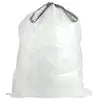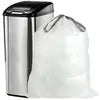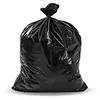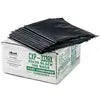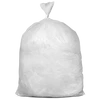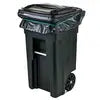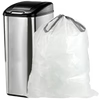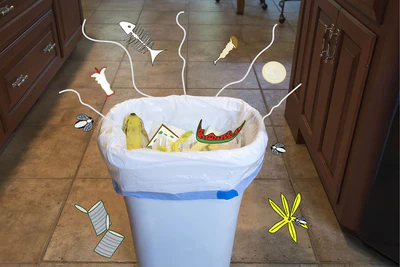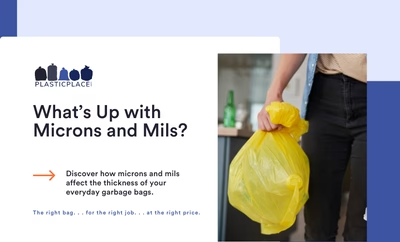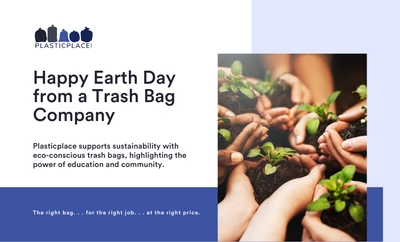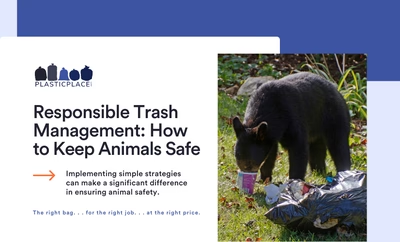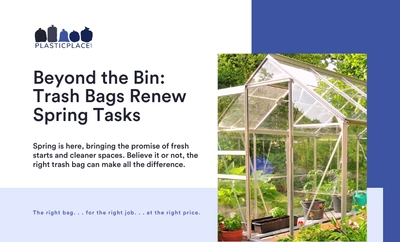The Truth About Biodegradable Trash Bags … and the Compostable Alternative
Plastic has changed our world. It has touched almost every facet of our lives from the way we drink, live, eat, care for our sick, package items, carry our belongings, etc. A great deal of it has brought powerful, important changes. However, today we are better educated about the negative impact it can have on the environment. We also recognize improperly discarded plastic is one of the most urgent problems facing the environment today. Plastics accounted for 12 percent of the 292 million tons of municipal solid waste generated in the U.S. in 2018, totaling some 35.7 million tons. However, the volume of plastic waste recycled in the U.S. that year was 3.1 million tons, giving a recycling rate of just 8.7 percent.
Being so aware of this conflict is what drives our commitment to finding greener ways of dealing with trash, especially when it comes to the production and disposal of plastic bags. It has also driven innovation: biodegradable plastic bags have been inspired by the need for environmental change. But like all new technologies, a great deal of information has been misunderstood. There are still some “secrets” surrounding the world of biodegradable trash bags.
Secret #1: The term “biodegradable” (and sister terms) is often misunderstood.
To best define what “biodegradable” means in the trash bag world, comparisons can help to better understand what it is and what it is not.
“Regular” trash bags are made from a synthetic material created from petrochemicals. Without boring you with the science that fascinates us — basically, the long polymer chains in traditional plastics like polyethylene are so resilient and resistant to breakdown that they can last for hundreds of years. These are the dirty holdouts of the plastic world — the ones that will be around for generations.
Biodegradable plastic is also made from petrochemicals BUT is manufactured differently so that it can begin to break down more quickly in the presence of air and sunshine. You might see this plastic labeled as photodegradable or oxo-degradable.
Bioplastic is a biobased plastic that comes from renewable biomass, meaning plants. It is made from organic, renewable sources, such as vegetable oils, corn starch and grains. It is even made sometimes from algae and seaweed!
Secret #2: Biodegradables are the “Wild West” of trash bags.
One of the first problems with “biodegradable plastic” was that, in the early days, there was no consensus on what qualified as biodegradable and therefore it has evolved in a way that is not regulated.
Dubious claims abounded as companies rushed to get on the green bandwagon and made all kinds of promises to consumers that were simply not true.
Eventually, the Federal Trade Commission (FTC) stepped in with a strict set of guidelines defining exactly what could and could not be labeled as biodegradable. For a full explanation, you can take a look at the “Truth in Advertising” section of the FTC Green Guides here, but in short, when the term “biodegradable” is used for marketing purposes, it includes a time component regarding the length of time it takes for the plastic to fully degrade. According to the EPA, an item truly qualifies as “biodegradable” if the items completely decompose within one year after customary disposal. Items that are customarily disposed of in landfills , incinerators and recycling facilities are deceptive because these locations do not present conditions in which complete decomposition will occur within one year.
Even today, while the American Society for Testing and Materials (ASTM International) sets definitions and standards (which we’ll discuss in a minute), and the Federal Trade Commission is responsible for enforcement against false or deceptive product labeling, there is little solid standard and burden of proof for biodegradability since so much is on the consumer to dispose properly.
That is because so much of a bag being biodegradable depends on…
Secret #3: Location, location, location.
One of THE MOST important aspects of using biodegradable products is where and how it is disposed. Beyond how a bag is manufactured or what it is composed of, the location of its final destination will also define the effectiveness of the product.
Most biodegradable garbage bags end up in landfills but the conditions in a landfill are extremely hostile to the biodegrading process. Nothing is meant to decompose there: air, moisture and sunlight, the three factors most necessary to decomposition, are purposely kept out of landfills to cut down on greenhouse gas emissions.Instead, a biodegradable trash bag must be disposed of in a place where it can receive the proper amount of oxygen and airflow. Many customers are unaware that landfills, incinerators and recycling facilities DO NOT offer this. Therefore, to complete its “destiny” as a biodegradable bag, it must be disposed of properly — typically in an industrial-grade composting facility.
Simply put, you cannot send biodegradable bags to a landfill and expect it to have any positive environmental impact. They will overstay their welcome on this planet like regular plastic.
Secret #4: The dream job of all biodegradables is “bio-assimilation.”
The ideal function of a biodegradable garbage bag or any bag striving to be a good environmental citizen is bio-assimilation. If a bag "bio-assimilates,” it means that the plastic has degraded to a molecular weight that can be consumed by living organisms. Imagine…trash as food. Only when there is no trash of the bag left behind have we received the final nirvana. This final and conclusive stage of plastic biodegradation leaves behind no microplastics, in both marine and terrestrial environments.
Secret #5: You may be saying “biodegradable” when in reality you want compostable.
We like to say that a compostable bag is a “lazy environmentalist’s” dream — it does all the work with far less human confusion.
Because of its unique chemical properties, compostable trash bags will do just that: turn to compost more easily. In other words, you can’t just throw a biodegradable trash bag on your compost pile and think it will decompose. It can’t — the temperature won’t get hot enough. But compostable trash bags will turn into compost sometimes, right in your own backyard. (Please note: If your compostable bag can be used at home, the label will indicate that the product is okay for home composting.) To learn more about composting at home and how to do it right, visit EPA Guide to Composting.
Otherwise, generally, compostable waste bags are intended to be sent to an industrial or commercial composting facility that contains higher temperatures and different breakdown conditions than those found in a typical homeowner’s compost bin. Again, don’t expect a compostable trash bag to break down in your backyard composter unless it specifically says it’s suitable for home composting use.A great first step is to check if your community has a residential compost collection program. They will be able to help you better understand whether compostable garbage bags will be accepted under this program.Shop Our Collection of Compostable Trash Bags Here
Secret #6: Look for compliance with the ASTM D6400 standard to help you determine when garbage bags are actually compostable.
The ASTM D6400 standard is the best indicator to use if you’re hunting for compostable trash bags. This standard defines what plastics should be called “compostable” according to how much of a given plastic bag decomposes within a set amount of time, given the right conditions like heat and moisture.
One easy way to find out if a product is compliant with this standard is to look for plastic products with the BPI Certified Compostable logo. The Biodegradable Products Institute (BPI) is an independent environmental group that works with bioplastics businesses to test and certify their products as biodegradable or compostable. If your trash can liners are BPI Certified Compostable, as Plasticplace’s compostable trash bags are, you can be confident that they’ve been put through rigorous third-party testing to confirm their ASTM D6400 compliance.
Note that a BPI/ASTM certification only tells you whether a product will undergo degradation in industrial and municipal composters. Many BPI-certified products still aren’t intended for backyard composting, so once again, don’t put a compostable trash bag into the backyard compost with your food scraps. If you’re really curious about the trashy details, you can read up on the BPI’s labeling guidelines.
All that aside, compostable trash bags are the number one choice for anyone seeking an eco-friendly trash bag option. They can take a big bite out of your home or business’s plastic footprint, and they’re especially important for California residents taking part in the state’s mandatory composting program. Naturally, this is why all of Plasticplace’s compostable garbage bags are BPI certified for ASTM D6400 compliance!
Secret #7: Compostable trash bags need to be filled with compost.
Remember that non-compostable trash should never go into a compostable trash bag. If you send your local compost facility a compostable trash bag filled with non-compostable plastic waste, like plastic grocery bags, that waste has no path to its proper spot in the landfill. It will end up as a contaminant at your compost facility. Instead, fill your compostable garbage bags with traditional compost materials like food waste and yard waste (plus any other certified compostable materials you might need to throw away). Check your local composting center’s regulations to verify what kind of materials they do and don’t accept.
Secret #8: Biodegradable concepts perpetuate single-use plastic use.
The concept that we are buying a “biodegradable” bag or “environmentally friendly” bag allows us to use one-time plastics more “guilt-free.” This mentality can lead to an increase in plastic use. Once it's understood that a biodegradable bag will still have a significant environmental impact, especially when improperly disposed of, it is easier to accept the importance of minimizing one-time plastic use and recycling.
Foremost, when possible, select reusable products instead of disposable ones.
Secondly, recycling bags can make it easier to recycle your plastics. For an extra measure of eco-friendliness, you can also choose recycled plastic trash bags. These bags are manufactured by existing plastic so you are recycling as you are recycling!
GET A SAMPLE FOR ONLY $4 PLUS FREE SHIPPING
13 Gallon Compostable Trash Bag
 4.9 out of 5
4.9 out of 5  Mix and Match: Buy any two products for 10% off!
Mix and Match: Buy any two products for 10% off!













